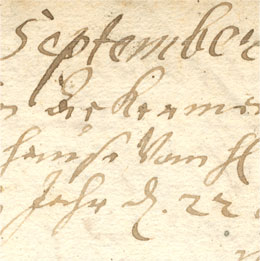When was the Vigala Church retable completed and who commissioned it?
A new retable was commissioned for Vigala’s medieval church at some point in the latter half of the 1680s. Johann Heinrich von Derfelden, a member of Sweden’s Horse Guards, the local Mannrichter (district court judge), and the owner of Kloostri Manor, and his wife Katharina Agneta von Üxküll, daughter of Jürgen von Üxküll, who was a churchwarden of Vigala and the former owner of Vigala Manor, commissioned the work. Their coats-of-arms were mounted in the middle of the retable.
Who did what in the making of the retable?
Stylistic analysis indicates that Christian Ackermann fashioned the carvings for the Vigala Church retable together with his assistants. The master cabinetmaker did the planeing work. The painter coated the work of the cabinetmaker and of the carver with paints, lustre, and gilding. The names of the masters who worked together with Ackermann are not known.
Ackermann carved the retable’s décor largely by himself, further developing what he had done for the Simuna retable in regard to the ornamentation. In terms of carving statues, Ackermann further developed the figures he made for Simuna, and in the case of the statues and St. Peter and St. Paul, he further developed the figures that he made for Tallinn’s Cathedral.
Ackermann similarly carved a pelican feeding its chicks with its own blood for the Vigala Church retable cornice. This pelican brought to mind the eagle made for the shield of Ewaldt Gustaw von Schütz’s coat-of-arms epitaph, which was completed earlier and mounted on the wall of Tallinn’s Cathedral.
Additionally, Ackermann carved several allegorical virtues for the Vigala retable together with his assistant: the statues of Faith with a cross and Hope with an anchor, Love (?) (which had lost its attribute) and the Church (?) with a chalice. Some allegorical virtues adopted from ancient philosophy – Clemency with a lamb and Fortitude with a column – on the reliefs adorning the retable’s columns were meant to supplement those four virtues in Vigala Church.
From where did Ackermann and the masters who worked together with him draw inspiration for their work?
Ackermann carved reliefs of Clemency with a lamb and Fortitude with a column for the retable’s columns with the help of printed models.
Cabinetmakers and painters also used printed models. The master who painted the picture The Last Supper on the Vigala retable’s central panel and wrote his initials H. S. in its corner probably did so as well.
The painter’s signature in the corner of The Last Supper is more of an exception instead of a rule – Ackermann did not leave his signature on any of his works. Even Ernst Wilhelm Londicer, who returned to Tallinn in 1683 and established himself as an independent master, is known to have signed only one of his works: in 1678 on his portrait of Gerhardt Lode.
The painting The Crucifixion of Christ on the retable’s additional storey is unsigned. The picture’s format is smaller, and its composition is more complex than The Last Supper. It was painted using finer paintbrushes and even brighter colours. The density and great detail of the painting’s composition indicate that an engraving similarly served as the model for the painting.
How expensive was the Vigala Church retable?
It is not known how much the Vigala Church retable with its seven figures, rich ornamentation and two paintings cost the persons who commissioned it and how the remuneration for it was divvied up among the different masters. Judging by the retable’s abundant décor and the original polychromy and the gilding found in the course of examinations of the retable, it is likely that it was a very costly piece of work.
Still, regardless of all its baroque glory and splendour, the retable’s original design did not survive. The original central painting on the theme of the Last Supper was replaced in the 19 century with a copy of Hermann Hoffmann’s painting Christ in the Garden of Gethsemane (which has been removed). The entire architectonics, ornamentation, and some of the statues of the retable were repainted in 2006.





